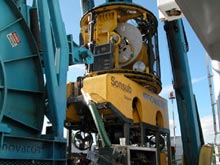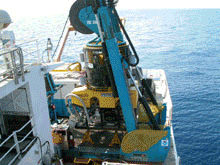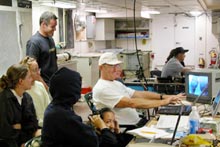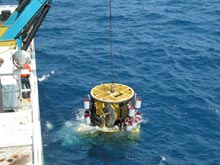
Many hours were spent mobilizing the Innovator from the stern deck of the NOAA ship Ronald H. Brown. Click image for larger view and more details.
Cross Your Fingers
September 9, 2003
Gary K. Wolfe
Marine and Environmental Education
Eau Gallie High School
Rollins College, Brevard, FL
Taconya D. Piper
NOAA Office of Ocean Exploration
When you think of scientists conducting research, the last thing that enters your mind is luck. Most of us think of the men and women in science as the best and the brightest of humankind, and that they employ logic and proven methods, as opposed to luck, to examine our world. In the real world of science, however, sometimes things are not that clean and packaged. Today is our first full day out from port in St. Petersburg, FL. We will be putting technology, science, and our confidence to the ultimate test. Luck has nothing to do with it -- or so I thought. That was before I noticed everyone aboard the ship with his or her fingers crossed.
In a few hours, we will rely on scientific and technological expertise and months of preparation to accomplish something that has never been tried before, the use of an industrial ROV (remotely operated vehicle) to survey and collect specimens from the ocean depths. This will truly be an example of exploration. The Innovator, built and operated by Sonsub Inc., is an ROV that was built to do just about anything. The Innovator is normally used to work with equipment on oil rigs and other large structures on the ocean floor; this ROV appears primed and ready to put on an interesting show. The ROV pilot and a team of scientists sit in a large, truck-like container, located on the aft deck of the ship, known as the "van." The pilot and scientists work together to guide the ROV to its designated collection site and to collect specimens.
In the ship's main lab, scientists and observers can watch real-time footage of the ROV on monitors and listen to the activity in the van while recording important data for later analyses. As the pilot guides the ROV for a "walk" along the ocean floor, I imagine that spectators will be glued to the monitor watching this live show. With specially designed robotic arms that can grab delicate sea fans, other gadgets that can "slurp up" loose bottom fauna, and the ambitious dive schedule, this marine workhorse will be put to the ultimate test during the next two weeks. Like a big dog on a long leash, the Innovator must respond to commands from the surface hundreds or even thousands of feet above.

The Innovator ROV being launched from the stern deck of the NOAA Research Vessel Ronald H. Brown. ![]() Click image to view a slideshow.
Click image to view a slideshow.
The Innovator must be ready to respond to commands on a moment's notice. It must be able to obey what it is asked to do without delay. One mistake, one unexpected course change, would result in a very fast end to this expedition. Sonsub's underwater ROV has a proven track record and is more then capable of diving to depths greater then 3,000 m. This offers the scientific party from Harbor Branch Oceanographic Institution a tremendous amount of confidence that the project will be successful. Questions and concerns, of course, still remain. Will the technical complexities of this equipment be resolved? Can we maximize the capability of this ROV with that of Harbor Branch's Johnson-Sea-Link, a manned submersible? Will the quality of data collected be sufficient for use in the laboratory?
Testing the Innovator

Scientist John Reed, looking pleased, shows a few members of the science party real-time footage from the Innovator during the test dive. Back row (l to r): Priscilla Winder, Gail Samples, Alan Duckworth. Front row (l to r): Laura Rear, Tara Pitts, John Reed). Click image for larger view and more details.
Today, the Innovator will make a test dive to make certain that all of the attached equipment works properly, that there are no water leaks, and to ultimately assure that the ROV is ready for the tasks of this mission. As we stood on the ship's weather decks waiting for the test dive, many of us wondered, "Will it work?" "What's going on?" and "What's going to happen?" Considering the amount of time it took to get the Innovator lifted from the stern of the ship (more than 30 minutes), its descent into the water came and went with a flash. If you turned your head for a second you missed it. This was not the slow descent I expected, but a little excitement at sea does everyone good.
The test dive went very well. There were a few minor problems, but the first collection dive will go forth as scheduled. After the test dive, the Sonsub Inc. crew needed to replace malfunctioning cameras because the cables were water-logged. Without good cameras, the ROV can't focus in on the samples the scientists want to photograph and collect. With the wealth of expertise on this mission, however, our first collection dive is likely to go off without a hitch. Cross your fingers and wish us luck.
Sign up for the Ocean
Explorer E-mail Update List.






















